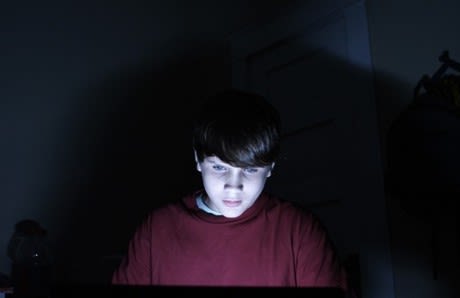A popular topic with conspiracy theorists and those who believe in malevolent forces beyond our realm of comprehension, the veracity of the "shadow people," as they're commonly called, is a subject worthy of exploration. Fascinating and balanced as the meat of the story may be, the inconsistent manner in which writer/director Matthew Arnold broaches the myth is both irresponsible and unsatisfying. Shadow People is touted as being based on the actual case of a bunch of mysterious deaths surrounding a talk radio program and the viral video known as "Sleep Study GR16 1971." To prove that it is, Arnold goes so far as to use archival footage and interviews with real people whenever possible, as is stated in a disclaimer at the beginning of the film. This approach gives the project an Unsolved Mysteries re-enactment feel. Frequently, when introducing a character, the movie goes split screen to show the fictionalized version side-by-side with the actual person being portrayed. While it lends credence to the story, the tactic is disruptive to the flow of the narrative. Make a movie or make a documentary, trying to have it both ways hurts the whole. What's most frustrating is that Arnold displays some decent filmmaking chops when he sticks to recreating the story instead of half-heartedly investigating it. After a collection of YouTube testimonials representing both believers and sceptics, and a short scene that sets up the oral tradition of meme transfer, with a little boy in Cambodia dying in his sleep after hearing a creepy legend, we meet small-town radio personality Charlie Crowe (Dallas Roberts, The Walking Dead, who's about two chins short of resembling the man he's portraying). In need of a serious ratings boost, Crowe finds fortune in misfortune when a young man calls in while having a nervous breakdown about shadow people waiting to kill him if he falls asleep. The disturbed caller discharges a gun while on air and dies in his sleep the following night, after being committed to a mental hospital. This spurs tons of late night radio listeners to call in to share similar experiences, driving the ratings through the roof. While reaping the rewards of such a salacious conversation piece, Crowe becomes consumed with finding the truth of the matter, especially after more and more mysterious deaths crop up in the wake of increased awareness of the phenomena. It gets so serious that the CDC (Centre of Disease Control) is called in to investigate. Arnold uses some subtly askew camera angles to give certain scenes a sense of unease, but he also begins taking undue liberties with events that couldn't have been seen or reported by anyone to make Shadow People more of a traditional horror movie, which is completely at odds with how it's presented otherwise. Further conflicting with those cheap scare tactics, the handling of the actual topic is quite reasonable; it takes a balanced look at the potential causes of a strange phenomenon that has been proven to exist, but still eludes satisfactory explanation. "More to the Story," the only bonus feature included, contains interviews with a couple of specialists on the subject, focusing on the etymology of the word "nightmare" and the power of suggestion to influence the physical world. Those drawn to the material will find Shadow People interesting, but sloppy, while those just looking for a good scary movie will be sorely disappointed.
(Anchor Bay)Shadow People
Matthew Arnold

BY Scott A. GrayPublished Mar 22, 2013